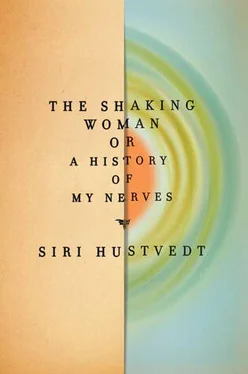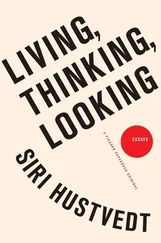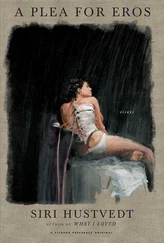The Brain authors do not know what to make of Neil’s case. They do say that his “performance” resembles “automatic writing, a dissociative phenomenon that was once the subject of intensive study in both experimental and clinical psychology.” 64They do not say that automatic writing was viewed as both a spontaneous symptom of and used as a therapy for hysteria. Janet employed the technique with hypnotized patients to bring out traumatic narratives that had split off from their conscious minds. His theory was that these patients were not capable of integrating the sensory material that had bombarded them, which then resulted in a dissociation of their sensorimotor processes. When he suggested that they write under hypnosis, the narratives they spontaneously produced helped make them aware of what had gone underground. Neil’s brain damage created a split — his consciousness did not include what his writing hand appeared to remember. The authors also mention a 1986 study of two “neuropsychiatric patients” with temporal lobe epilepsy and an affective disorder who produced pages of text without knowing it. Surely these phenomena are related. The question is, How? And why do the researchers, who seem aware of the earlier medical history, resist discussing it?
Automatic writing was widely studied in the late nineteenth and early twentieth centuries. In his book Psychopathology of Hysteria published in 1913, Charles D. Fox describes the phenomenon (in prose that reminds us jargon is nothing new to medicine):
In order that automatic writing can occur there must be a coexistent dissociation of consciousness with elimination of the automatically functionating extremity from the field of consciousness. Not only are the motor functions dissociated but, commonly, the member as a whole is elided from consciousness with the result that sensory impressions originating in the part are not consciously perceived. 65
Although the authors of the Brain paper claim that Neil’s case has no precedent, which may be true, there is a related and famous case: A. R. Luria’s patient Zazetsky, whom the neurologist chronicled in his book The Man with a Shattered World . After a severe injury in the Second World War, in which the left parieto-occipital areas of his brain were damaged, Zazetsky found himself with grave spatial and cognitive deficits. Like Neil, he could speak and repeat words, but he couldn’t remember his name or address or the words for the things around him. He sagely identified what had disappeared as his “speech memory.” After a couple of months in the hospital, he slowly began to recall fragments of his past, his name, mailing address, and more words:
I heard everything people around me were saying, and little by little my head was crammed with songs, stories, and bits of conversations I’d picked up. As I began to remember words and use them in thinking, my vocabulary became more flexible.
At first I couldn’t remember any of the words I wanted to use in a letter. But I finally decided to write home and quickly got off a letter — a short one, just a note. I was completely unable to read what I’d written and somehow didn’t want to show it to any of the patients. In order not to think about it and risk getting upset, I quickly sealed the envelope with my family’s address on it and sent it off to be mailed. [My italics.] 66
Zazetsky would always have terrible problems reading and understanding what he had written, but he could write and when he wrote he remembered, especially if he didn’t lift his writing hand from the page. In his voluminous notebooks, Zazetsky not only described the hardships caused by his ravaged brain, he also painstakingly brought back every memory he could extract from his scattered mind. Despite his disabilities, he was a man who retained a supreme sense of self-conscious awareness, a labile, thinking “I.” The extracts from Zazetsky’s notebooks reveal a person of remarkable character. Intellectually curious, analytical, and emotionally sensitive, Zazetsky bears decisive witness to the strange and distinct power of writing as a memory tool.
I OFTEN WONDER HOW much I’ve forgotten. Perhaps daily “I remember” exercises would help me recover lost pieces of my life. Neil seemed to have a memory system that was encoding and storing all kinds of daily memories in a “place” completely separate from his ordinary waking consciousness, which was badly impaired. Don’t reading and writing go together? In both Neil and Zazetsky, these seemingly related functions separated: one vanished; the other stayed. Do I shake because I have a systemic disconnection? A couple of times since the advent of propranolol in my life, the tremor has surprised me again. As I sat down to do a television interview for a Swedish program, I felt the buzz rise in my limbs. It had not occurred to me that I should have taken pills in anticipation. This was a small, relaxed affair — an interviewer and cameraman. They had set up in the back room of a restaurant. I felt tranquil until that tuning fork began to hum. I gripped the arms of the chair hard, praying it wouldn’t erupt into seizure-like spasms. It didn’t, but the fact that it didn’t seemed arbitrary, the whim of an unknown stranger. Another time, I was shocked to feel the first hint of the shudder when I was in my own house. I opened my mouth to read a small piece I had written for a young man who was gathering short stories about Berlin for a radio program. I excused myself and ran for the medicine cabinet.
Who are we, anyway? What do I actually know about myself? My symptom has taken me from the Greeks to the present day, in and out of theories and thoughts that are built on various ways of seeing the world. What is body and what is mind? Is each of us a singular being or a plural one? How do we remember things and how do we forget them? Tracking my pathology turns out to be an adventure in the history of experience and perception. How do we read a symptom or an illness? How do we frame what we observe? What is inside the frame and what falls outside it? Janet’s patients didn’t have brain scans, but Neil did. Neil’s scan does not explain his dissociated orthographic memory. Automatic writing once had a place in medical theory. Now it is an outcast, a curiosity that stuns researchers. Why?
Although interest in Janet has grown a little recently, most of his works have been out of print for years. From a historical point of view, a large part of the reason is hypnosis. When hypnosis was discredited in the late nineteenth century, the reputations of Charcot, Janet, and others who had used it on their patients were badly damaged. This is ironic because Charcot had rescued hypnotism from its association with the Austrian doctor Franz Anton Mesmer. Mesmer’s idea of cure by animal magnetism had caused a stir a century before Charcot, but his science was later soundly rejected by the medical establishment. Charcot revived the practice of hypnotism at the Salpêtrière, only to have his use of it damage his legacy. One of Charcot’s mistakes was to maintain that only hysterics could be hypnotized, a conviction that turned out to be false. As the Swedish physician Axel Munthe commented at the time, “If the statement of the Salpêtrière school that only hysterical subjects were hypnotizable was correct it would mean that at least eighty-five percent of mankind was suffering from hysteria.” 67The fact that Charcot staged elaborate public spectacles of hypnotized patients performing their illnesses for audiences also hurt him. He had a tendency to treat his patients as if they were props to demonstrate his theories. And, as Georges Didi-Huberman argues in his book Invention of Hysteria, Charcot’s use of photography as an “objective” tool to record the illness was rife with sexual bias and manipulations that created a vision of hysteria as fundamentally theatrical, an idea that has never left us. 68In ordinary parlance, hysteria still means dramatic emotional display. Early in his career, Freud hypnotized his patients and offered them suggestions, but he later admitted that he wasn’t good at it and stopped. He also found it convenient to distance himself from the French school, which had come under a barrage of criticism. Worries about the power of a doctor’s suggestions to influence and shape his patient’s mind, whether they are made under hypnosis or not, are still with us. The fear has haunted psychoanalysis, psychotherapy, and many forms of psychiatric treatment since Charcot. The bitter battles fought over memory, “recovered” and/or “false,” are a continuation of this very same dispute, albeit using different language.
Читать дальше












